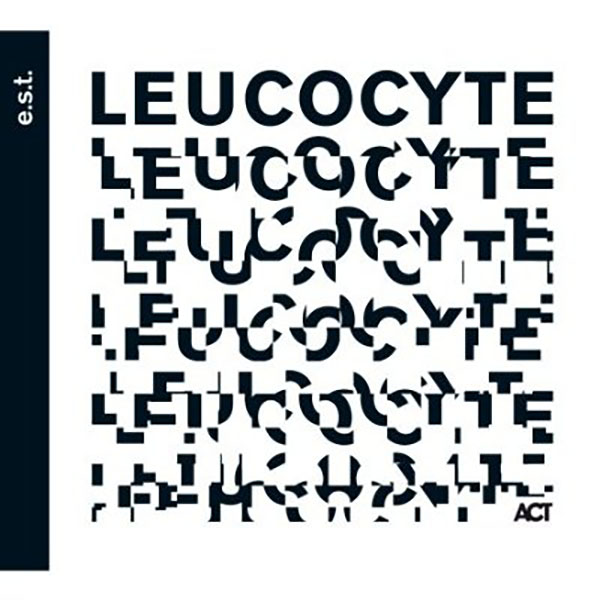
by Ian Mann
October 10, 2008
/ ALBUM
e.s.t.'s legacy "Leucocyte" is a major artistic statement in its own right
The now well documented death of pianist Esbjorn Svensson in a diving accident on 14th June 2008 inevitably casts a shadow over this recording.
“Leucocyte” will be the final record from e.s.t. unless there are subsequent compilations or releases of live material (the BBC must have some riches in the vaults). ACT have spoken of “Leucocyte” as being Svensson’s legacy and what a fine legacy it is.
e.s.t.‘s career was one of continuous artistic growth, a process that sadly reaches it’s conclusion with “Leucocyte”. The group’s previous release “Live In Hamburg” saw them embracing improvisation more fully and openly, stretching out expansively on material mainly drawn from their previous studio album “Tuesday Wonderland”.
“Leucocyte” finds them taking this process a stage further with the music contained therein stemming entirely from improvisation. During e.s.t.‘s Australian tour they hired a studio in Sydney where they jammed for two days, literally composing on the spot. The tapes were then taken back to Gothenburg for mixing by e.s.t’s faithful sound man Ake Linton. The album and artwork had already been delivered to ACT before Svensson’s death. After much soul searching they decided to go ahead and release the album and the aural evidence makes it clear that they were quite right to do so. “Leucocyte” is an excellent album in it’s own right and one of the most uncompromising records e.s.t have ever made.
The album takes it’s title from the medical term for white blood cells, essential to life but mockingly ironic in the wake of subsequent events. Nonetheless this is perhaps the darkest album of e.s.t.‘s career in the musical sense. The brief opening solo piano reflections of “Decade” lead into the intense and brooding two part “Premonition”, an unfortunately apt title. Drummer Magnus Ostrom has always provided e.s.t.‘s evocative song titles but whether the titles on “Leucocyte” were chosen before or after the tragedy is not made clear.
In any event Part I “Earth” builds out of Dan Berglund’s bass ruminations into a seventeen minute tour de force featuring all the classic e.s.t. hallmarks-ecstatic piano improvisations, subtle electronic effects, dynamic rock/jazz drumming and so on. Unlike previous releases all compositions are credited to the group and it is remarkable that this glorious kaleidoscope of sound should grow from such simple beginnings.
Part 2 “Contorted” is more impressionistic and frankly spooky with ghostly electronic effects swirling in and out of the piano/bass melodies.
There is even a track called simply “jazz” which features Svensson soloing joyously over Berglund’s walking bass line and Ostrom’s splashy drumming. Svensson’s spontaneous vocal nods in the direction of the great Keith Jarrett, one of his early influences.
“Still” develops from the opening electronic effects. Electronica plays a more prominent part on this album than ever before. E.s.t. have always absorbed other ideas into their music. Their use of technology suggests an affinity with the likes of the Norwegian band Supersilent or our own Polar Bear.
“Ajar”, another pastoral piano interlude leads into the four part “Leucocyte” itself. Part I “Ab Initio” is e.s.t. in all their rock glory, a monster riff, distorted bass and furious drumming but still finding room for Svensson’s impassioned piano.
Part II “Ad Interim” is a minute of silence-add John Cage to the list of influences-before Part III “Ad Mortem” takes over growing out of a soup of electronica and treated piano. It’s probably the most avant garde piece the group have ever recorded, reminiscent perhaps of blood surging and bubbling in the veins, of the struggle between leucocytes and pathogens. Eventually reconciliation is reached and a lilting piano melody picks a way through the electronic landscape.
In the closing Part IV “Ad Infinitum” a single treated phrase is looped in the style of Steve Reich over a subtly changing electronic backdrop and other elements are slowly layered on in a kind of “musique concrete”.
“Leucocyte” is an essential purchase for any fan of contemporary music. Rock listeners will derive much from e.s.t.. a group who invite comparison with Radiohead in their ability to experiment in public without sacrificing their popular appeal. That this is to effectively be the last chapter in the e.s.t. story adds poignancy but “Leucocyte” is a major artistic statement in it’s own right showing that e.s.t. were still developing, introducing new ideas and pushing the musical envelope right to the end.
Who knows what else would have come from them but let us hope that Ostrom and Berglund, both vital components of this remarkable group will in time be able to find other outlets for their considerable creative talents.
In the meantime we have “Leucocyte”. Listen and enjoy, revisit the back catalogue, and give thanks for the life of Esbjorn Svensson. His influence and legacy live on.
blog comments powered by Disqus